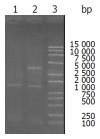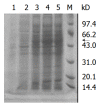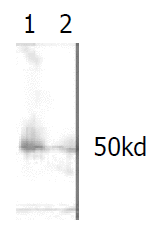Cloning and expression of ornithine decarboxylase gene from human colorectal carcinoma
- PMID: 12679917
- PMCID: PMC4611435
- DOI: 10.3748/wjg.v9.i4.714
Cloning and expression of ornithine decarboxylase gene from human colorectal carcinoma
Abstract
Aim: To construct and express ODC recombinant gene for further exploring its potential use in early diagnosis of colorectal carcinoma.
Methods: Total RNA was extracted from colon cancer tissues and amplified by reverse-transcription PCR with two primers, which span the whole coding region of ODC. The synthesized ODC cDNA was cloned into vector pQE-30 at restriction sites BamH I and Sal I which constituted recombinant expression plasmid pQE30-ODC. The sequence of inserted fragment was confirmed by DNA sequencing, the fusion protein including 6His-tag was facilitated for purification by Ni-NTA chromatographic column.
Results: ODC expression vector was constructed and confirmed with restriction enzyme digestion and subsequent DNA sequencing. The DNA sequence matching on NCBI Blast showed 99 % affinity. The vector was transformed into E. coli M15 and expressed. The expressed ODC protein was verified with Western blotting.
Conclusion: The ODC prokaryote expression vector is constructed and thus greatly facilitates to study the role of ODC in colorectal carcinoma.
Figures




Similar articles
-
Ornithine decarboxylase gene is overexpressed in colorectal carcinoma.World J Gastroenterol. 2005 Apr 21;11(15):2244-8. doi: 10.3748/wjg.v11.i15.2244. World J Gastroenterol. 2005. PMID: 15818733 Free PMC article.
-
Genetic alterations of the ornithine decarboxylase gene in human colorectal cancers.J Exp Clin Cancer Res. 2002 Jun;21(2):191-5. J Exp Clin Cancer Res. 2002. PMID: 12148577
-
Analysis of ornithine decarboxylase messenger ribonucleic acid expression in colorectal carcinoma.Dis Colon Rectum. 1997 Sep;40(9):1095-100. doi: 10.1007/BF02050936. Dis Colon Rectum. 1997. PMID: 9293942
-
Lentiviral vector-mediated downregulation of ornithine decarboxylase inhibits tumor cell growth in vitro and in vivo.Tumour Biol. 2006;27(5):243-51. doi: 10.1159/000094843. Epub 2006 Jul 28. Tumour Biol. 2006. PMID: 16888408
-
Isolation and characterization of ornithine decarboxylase gene from flounder (Paralichthys olivaceus).Mar Biotechnol (NY). 2004 Sep-Oct;6(5):453-62. doi: 10.1007/s10126-004-4100-3. Epub 2004 Jul 30. Mar Biotechnol (NY). 2004. PMID: 15791490
Cited by
-
Expression of PCNA and CD44mRNA in colorectal cancer with venous invasion and its relationship to liver metastasis.World J Gastroenterol. 2003 Dec;9(12):2863-5. doi: 10.3748/wjg.v9.i12.2863. World J Gastroenterol. 2003. PMID: 14669354 Free PMC article.
-
Expression of ornithine decarboxylase in precancerous and cancerous gastric lesions.World J Gastroenterol. 2007 May 28;13(20):2867-71. doi: 10.3748/wjg.v13.i20.2867. World J Gastroenterol. 2007. PMID: 17569126 Free PMC article.
-
Adenovirus vector-mediated upregulation of spermidine /spermine N1-acetyltransferase impairs human gastric cancer growth in vitro and in vivo.Cancer Sci. 2009 Nov;100(11):2126-32. doi: 10.1111/j.1349-7006.2009.01290.x. Epub 2009 Jul 21. Cancer Sci. 2009. PMID: 19686286 Free PMC article.
-
Comparative evaluation of immune response after laparoscopical and open total mesorectal excisions with anal sphincter preservation in patients with rectal cancer.World J Gastroenterol. 2003 Dec;9(12):2690-4. doi: 10.3748/wjg.v9.i12.2690. World J Gastroenterol. 2003. PMID: 14669314 Free PMC article.
-
Ornithine decarboxylase gene is overexpressed in colorectal carcinoma.World J Gastroenterol. 2005 Apr 21;11(15):2244-8. doi: 10.3748/wjg.v11.i15.2244. World J Gastroenterol. 2005. PMID: 15818733 Free PMC article.
References
-
- Jeevanandam M, Petersen SR. Clinical role of polyamine analysis: problem and promise. Curr Opin Clin Nutr Metab Care. 2001;4:385–390. - PubMed
-
- Auvinen M. Cell transformation, invasion, and angiogenesis: a regulatory role for ornithine decarboxylase and polyamines? J Natl Cancer Inst. 1997;89:533–537. - PubMed
-
- Bowlin TL, McKown BJ, Davis GF, Sunkara PS. Effect of polyamine depletion in vivo by DL-alpha-difluoromethylornithine on functionally distinct populations of tumoricidal effector cells in normal and tumor-bearing mice. Cancer Res. 1986;46:5494–5498. - PubMed
-
- Umar A, Viner JL, Hawk ET. The future of colon cancer prevention. Ann N Y Acad Sci. 2001;952:88–108. - PubMed
-
- Rozhin J, Wilson PS, Bull AW, Nigro ND. Ornithine decarboxylase activity in the rat and human colon. Cancer Res. 1984;44:3226–3230. - PubMed
Publication types
MeSH terms
Substances
LinkOut - more resources
Full Text Sources
Medical
Molecular Biology Databases
Research Materials

